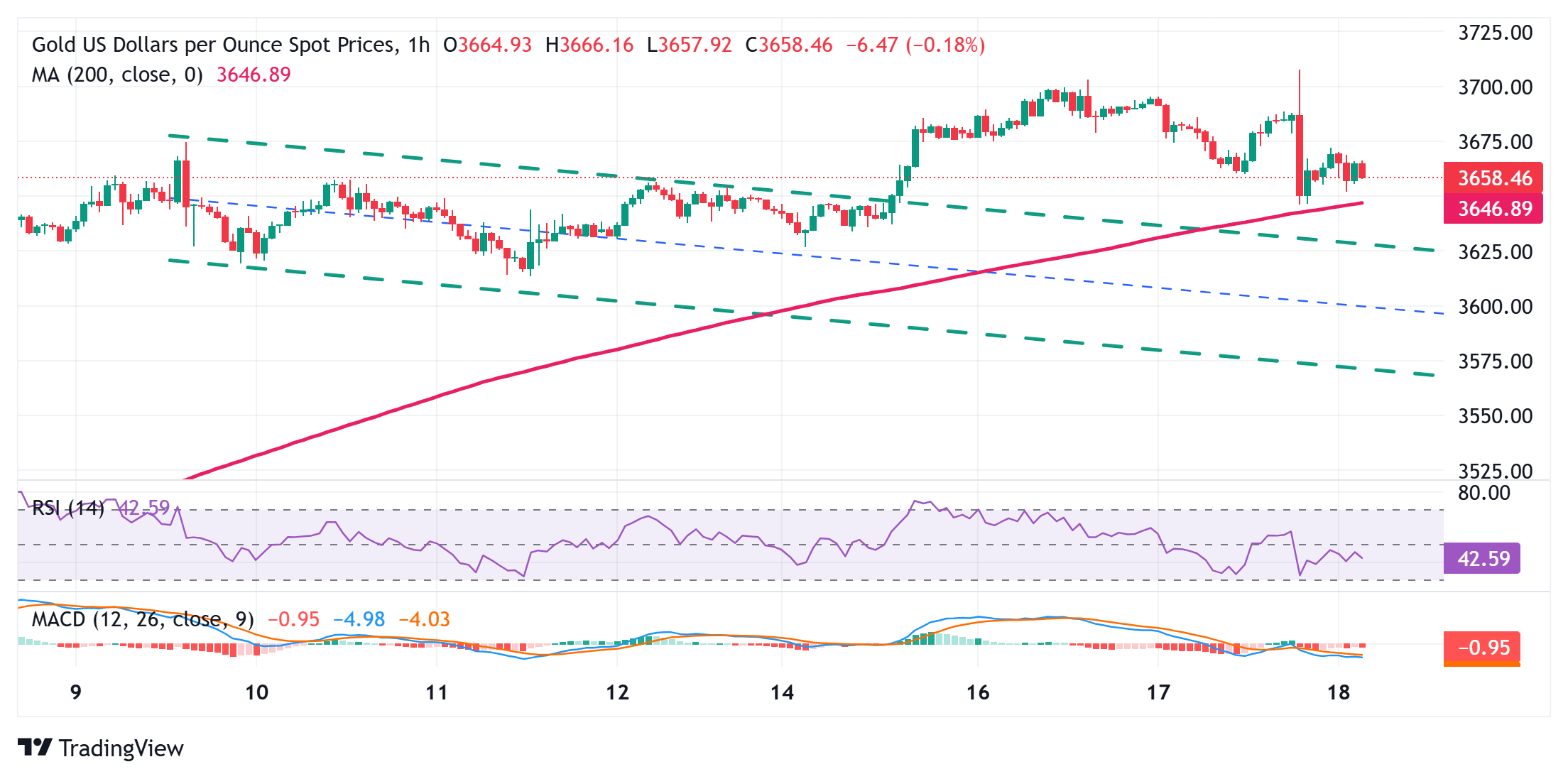Created
: 2025.09.18














![]() 2025.09.18 13:19
2025.09.18 13:19
Gold (XAU/USD) is seen consolidating the previous day's retracement slide from the record high, levels beyond the $3,700 mark, touched in the aftermath of the FOMC dovish rate cut. In fact, the US central bank signaled two more rate cuts by the end of this year, which, in turn, acts as a tailwind for the non-yielding yellow metal during the Asian session on Thursday. Furthermore, the risk of a further escalation of geopolitical tensions, amid the intensifying Russia-Ukraine war and conflicts in the Middle East, turns out to be another factor lending support to the safe-haven commodity.
In the post-meeting press conference, Fed Chair Jerome Powell indicated that Wednesday's move to lower interest rates was a risk management cut and added that he doesn't feel the need to move quickly on rates. This could assist the US Dollar (USD) to build on the previous day's solid intraday recovery from its lowest level since February 2022, which, in turn, might put a lid on the Gold price. Nevertheless, the fundamental backdrop seems tilted in favor of the XAU/USD bulls, suggesting that any further downfall could be seen as a buying opportunity and is likely to remain limited.

The daily Relative Strength Index (RSI) remains in the overbought territory and might further prompt profit-taking around the Gold. That said, the overnight bounce from the vicinity of a bullish flag pattern resistance breakpoint, now turned support, near the $3,645 region, warrants caution for the XAU/USD bears. Hence, it will be prudent to wait for some follow-through selling below the said area before positioning for further losses towards the $3,610-3,600 area.
On the flip side, the $3,678-3,680 region could act as an immediate hurdle ahead of the $3,700-3,707 zone, or the record high set on Wednesday. A sustained strength beyond the latter will be seen as a fresh trigger for bullish traders and should allow the Gold price to build on the recent breakout momentum and prolong a well-established uptrend witnessed over the past month or so.
Monetary policy in the US is shaped by the Federal Reserve (Fed). The Fed has two mandates: to achieve price stability and foster full employment. Its primary tool to achieve these goals is by adjusting interest rates. When prices are rising too quickly and inflation is above the Fed's 2% target, it raises interest rates, increasing borrowing costs throughout the economy. This results in a stronger US Dollar (USD) as it makes the US a more attractive place for international investors to park their money. When inflation falls below 2% or the Unemployment Rate is too high, the Fed may lower interest rates to encourage borrowing, which weighs on the Greenback.
The Federal Reserve (Fed) holds eight policy meetings a year, where the Federal Open Market Committee (FOMC) assesses economic conditions and makes monetary policy decisions. The FOMC is attended by twelve Fed officials - the seven members of the Board of Governors, the president of the Federal Reserve Bank of New York, and four of the remaining eleven regional Reserve Bank presidents, who serve one-year terms on a rotating basis.
In extreme situations, the Federal Reserve may resort to a policy named Quantitative Easing (QE). QE is the process by which the Fed substantially increases the flow of credit in a stuck financial system. It is a non-standard policy measure used during crises or when inflation is extremely low. It was the Fed's weapon of choice during the Great Financial Crisis in 2008. It involves the Fed printing more Dollars and using them to buy high grade bonds from financial institutions. QE usually weakens the US Dollar.
Quantitative tightening (QT) is the reverse process of QE, whereby the Federal Reserve stops buying bonds from financial institutions and does not reinvest the principal from the bonds it holds maturing, to purchase new bonds. It is usually positive for the value of the US Dollar.
![]()
Created
: 2025.09.18
![]()
Last updated
: 2025.09.18

FXStreet is a forex information website, delivering market analysis and news articles 24/7.
It features a number of articles contributed by well-known analysts, in addition to the ones by its editorial team.
Founded in 2000 by Francesc Riverola, a Spanish economist, it has grown to become a world-renowned information website.
We hope you find this article useful. Any comments or suggestions will be greatly appreciated.
We are also looking for writers with extensive experience in forex and crypto to join us.
please contact us at [email protected].
Disclaimer:
All information and content provided on this website is provided for informational purposes only and is not intended to solicit any investment. Although all efforts are made in order to ensure that the information is correct, no guarantee is provided for the accuracy of any content on this website. Any decision made shall be the responsibility of the investor and Myforex does not take any responsibility whatsoever regarding the use of any information provided herein.
The content provided on this website belongs to Myforex and, where stated, the relevant licensors. All rights are reserved by Myforex and the relevant licensors, and no content of this website, whether in full or in part, shall be copied or displayed elsewhere without the explicit written permission of the relevant copyright holder. If you wish to use any part of the content provided on this website, please ensure that you contact Myforex.
Myforex uses cookies to improve the convenience and functionality of this website. This website may include cookies not only by us but also by third parties (advertisers, log analysts, etc.) for the purpose of tracking the activities of users. Cookie policy